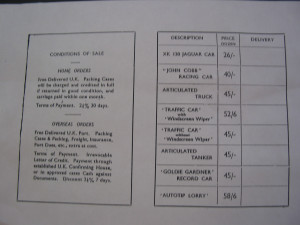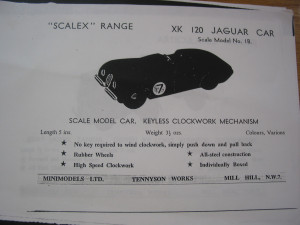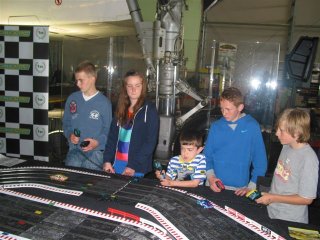The Ford Escort Mk l was launched onto the U.K. market in 1967 as a replacement for the aging Ford Anglia 105E, the charming late 50’s introduced version with the inward sloping rear window as modelled by ‘Spot-On’ (a sister Tri-Ang product to Scalextric during the early I mid 60’s).
It was the latest in a line of small Fords that stretched back to the side valve engined models of the post war years (sit-up and beg shaped Pops, Anglias and Prefects etc.). Naturally it did not take Ford Rallye Sport long to develop competition versions of the Escort, which included one of the earliest 4 WD competition models (this was the same period as the 4WD Capri’s which totally dominated the U.K. Rallycross scene for a brief period in the late 60’s).
With the success the works versions found in all types of motor sport, it was inevitable that Rovex would produce a works Ford Escort Mexico in its Scalextric range.
Whilst the variety of Escort Mexico’s produced was fairly limited, it is a range worth documenting because of a number of variations within models. C52 Ford Escort Special Build. First introduced in 1974 in catalogue 15, the C52 was the first Scalextric Escort to hit the streets.
It was available in two colours black and white, but each was slightly different. Black: came with yellow Tampo printed racing stripes on sides and bonnet/roof/boot. White:came as a plain body with decal sheets that allowed you to apply either red or yellow stripes depending on your preference. Cars with applied transfers in reasonable condition are hard to find, and cars with un-applied transfers that much harder again to find. When buying white Escorts be careful as, with most white cars, they have a tendency to yellow and are also prone to browning around the wheel arches (caused by the tyres).
This model was originally issued in the blue Rovex box, although most turn up in the later black window box. There is also a type variation in these cars.
Type l: the first batch appeared with a minor variation in the underpan. Instead of the standard guide post arrangement that was used on all subsequent Escorts, the first C52’s had a triangular hole in the underpan around the guide post through which the wires fed, similar to the Spanish design of the late 60’s early 70’s (as utilised on the U.K. assembled Spanish models 330GT, 917K, McLaren M23 etc. etc.), and were also fitted with chromed 5 spoke wheels. As far as I am aware the earlier type underpan was only fitted to the white car, and that combined with the fact that it had transfers not decals tends to suggest that the white C52 was released before the black version.
C118 Ford Escort Mexico. This was the first of the lighted Escorts, and was released as one of a pair of lighted cars (the other was the green/gold pinstripe. Porsche C119), which were in fact the first lighted cars to be released since El to E5 in the early 60’s.
As with all the Scalextric Escort Mexicos the model came with works arches and a lovely 4 spotlight chromed front bumper.
This model was released in 1980 (catalogue 2l ), and only remained in the range for approximately 2 years. They are reasonably easy to find suggesting a big batch must have been made. However, as with all Scalextric Escorts, examples with the original bumpers can be difficult to find. They came in a special elongated boxes (with a picture of a car with blazing lights headed towards you!) which were only used on five models, C 118, C287 Escorts and C119, C288 & C289 Porsche’s. This model was only available in black with gold pinstripes (what did Henry Ford say about’ Any colour so long as it is black’!) and there are no known variations of it.
C109 Ford Escort Mexico. This was also introduced in 1980 and again only remained until catalog 22 (1981 ). It was essentially an update of C52. Yet again the base color was black but this time is sported garish mid 70’s graphics -huge orange and yellow stripes (all the models of this era were similarly livered i.e.C110, Cl12, Cl13, Cl14,
Cl 15, Cl 16 etc. etc.). This was once again an unlighted Escort Mexico, and whilst reasonable looking it is probably the least popular of the five basic variations as it is the most toy like to look at.
C287 Westwood Racing Escort. The last Escort to be released, and finally a version that wasn’t black! This time Hornby choose another delightful summer color -brown!!
This in reality a little unfair as it was in fact a very attractive model. Caramel with a mid brown roof, ( can be difficult to find one with an unmarked roof), and decorated in ‘Westwood Racing’ livery
which was primarily red and yellow. All in all the best looking Escort produced, and probably the hardest to find (a close call between a nice Westwood and a nice C52!).
This car was the second of the lighted Escorts (available from 1981 to 1982) and there was a minor variation to look out for.
Type 1: The bulbs pushed through holes in the grille and then screwed into copper plates which conducted the current, whilst a second copper strip connected with the back of the bulb to complete the circuit.
Type 2: The bulbs fixed directly into the body of the car, and contacted the wiring by push on tags attached to an additional molding under the bonnet.
Variations
C52 Escort Mexico (French): Essentially the same model as the English C52. To the best of my knowledge only available in white. The key difference between English and French versions being the decal sheet French cars had. There were different transfers white blue stripes that went up and over bonnet, roof and boot, and secondly the cars came in the French style box. Plastic dome topped with a yellow plastic base -see page 147 of Roger Gillhams’ book for comparison.
Chromed cars: Factory produced chromed versions have been seen of both lighted and unlighted Ford Escorts, although as with any chromed car it is difficult to be sure unless you know its linage.
Others
Escort Mexico’s have recently been seen in both red and blue. However it is believed that these are not factory original items, and from close inspection appear to be manufactured in resin and not plastic, although for resin they are exceptionally good with little or no evidence of air bubbles. The main difference being depth of shine or lack of it on the cars body. If offered red or blue ( or any other odd colored) Escorts, be careful!!
All in all a charming representation of a classic rally car, a reasonably finite range of cars to locate, and none of the five basic models should cost more than £40 in today’s market making then an affordable target for the completist.
The only real mystery with the Escort is why Hornby have not re-released it. It is still to be seen on the roads today and would therefore appeal to enthusiastic young Scalextric fans (whose older brothers or Dad+ Uncles may even own one), and also appeal to the more mature collector.
Now who’s for a Power and Glory Escort Mexico in Daytona yellow?
Well no longer the finite range, the message did get through to Hornby and we have since seen dozens of other releases – its now possible to be an Escort only collector! On the plus side -the early ones disused in this article are regularly a lot less than £40 .
Julie Scale
























